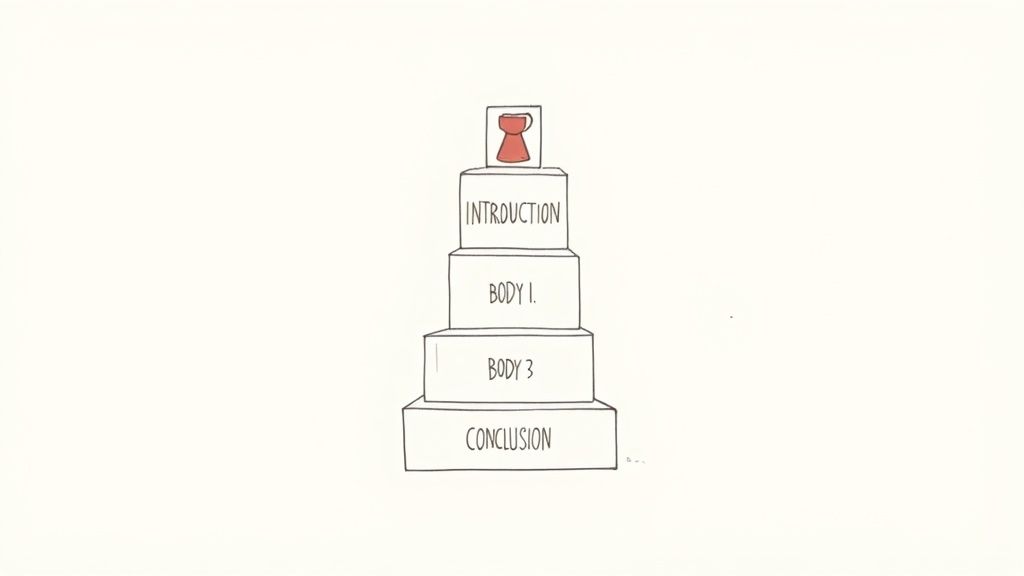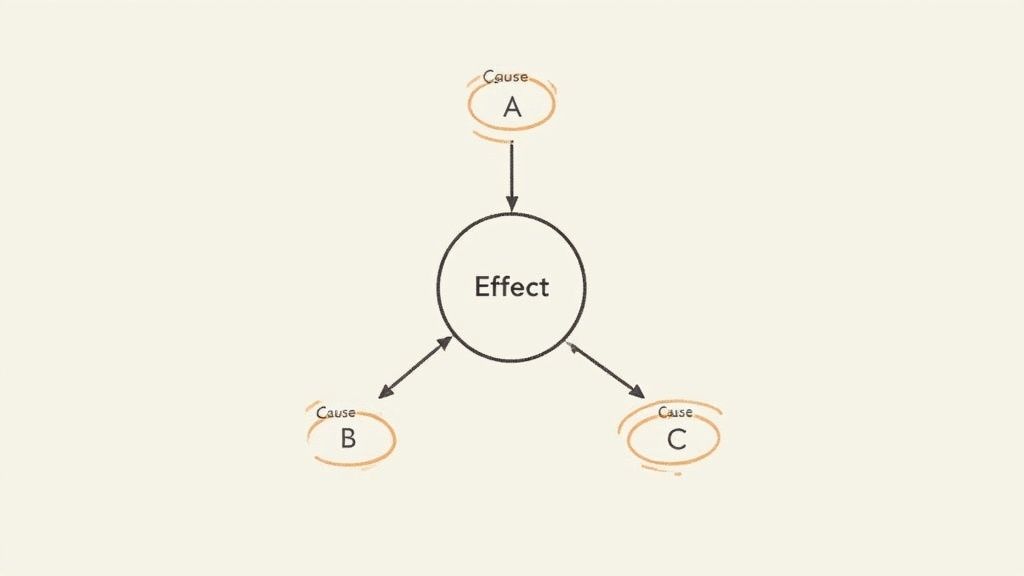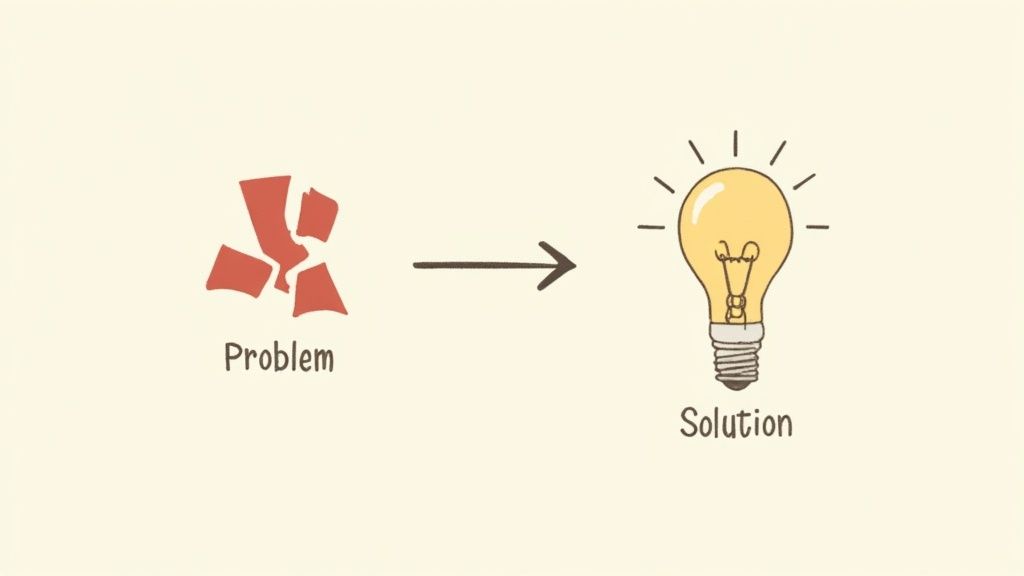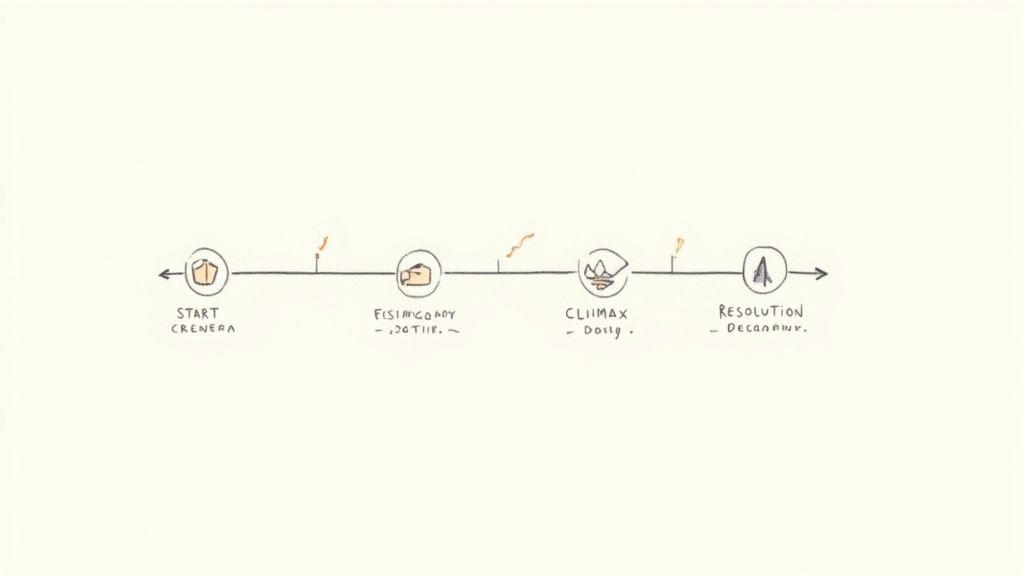Essay Structure Examples: Your Guide to Academic Excellence
This listicle provides seven essay structure examples to empower you with the organizational tools needed for effective communication and academic success. Whether you're writing a simple five-paragraph essay or a complex argumentative piece, understanding structure is key. We'll dissect each example, highlighting key features, advantages, and ideal use cases.
A well-structured essay facilitates clear and persuasive argumentation. It helps readers follow your logic, ultimately leading to better grades and more effective communication in any field. From high school assignments to professional reports, these structural principles remain crucial.
This comprehensive guide analyzes the following essay structure examples:
- Five-Paragraph Essay
- Compare and Contrast Essay
- Cause and Effect Essay
- Problem-Solution Essay
- Chronological/Narrative Essay
- Classical Argument (Aristotelian)
- Rogerian Argument
Each example will be broken down with specific outlines and sample paragraphs, demonstrating how to apply these structures effectively. We'll also delve into the strategic "why" behind each structural element, providing actionable takeaways you can use immediately. To streamline your essay writing process, explore the benefits of an AI Writing Assistant to assist with outlining and drafting. The AI Writing Assistant: Transform Your Content in 30 Days article from TypeBoost explains how these tools can be beneficial. Let's uncover the power of effective essay structuring!
1. Five-Paragraph Essay Structure
The five-paragraph essay structure is the cornerstone of academic writing. It provides a clear and organized framework for presenting arguments, making it ideal for beginners and experienced writers alike. This structure consists of an introduction, three body paragraphs, and a conclusion, creating a logical flow that's easy for readers to follow. This simplicity makes it particularly effective for standardized tests and assignments with strict word limits.

Why Use the Five-Paragraph Structure?
This structure excels in its ability to present a focused argument in a concise manner. It teaches writers to distill their ideas into essential points and support them with evidence. The defined structure helps ensure clarity and avoids rambling, making it perfect for high school essays, college applications, and even professional emails. It's a fundamental tool for building a strong writing foundation. Learn more about the Five-Paragraph Essay Structure
Examples in Action
The five-paragraph structure isn't limited to just academic essays. Its versatility allows it to be adapted for various purposes:
- High school essays: Persuasive essays on topics like school uniforms benefit from the structured format, enabling students to clearly articulate their viewpoints.
- Standardized tests: SAT and ACT essay responses often require concise, well-structured arguments, making this structure a go-to choice.
- College applications: When word limits are tight, the five-paragraph structure helps deliver a compelling narrative within the constraints.
- Argumentative essays: Exploring the impact of social media, for instance, can be effectively achieved through this structure.
Many resources can aid you when exploring essay structures. For example, you can use a free AI essay writers for assistance.
Actionable Tips for Success
Here are some key tactics to maximize the impact of your five-paragraph essay:
- Strategic Placement: Position your strongest argument in the final body paragraph to leave a lasting impression on the reader.
- Supporting Evidence: Back up each point in your body paragraphs with at least two pieces of evidence to enhance credibility.
- Sentence Variety: Incorporate different sentence structures to keep the writing engaging and prevent monotony.
- Smooth Transitions: Use connecting phrases between paragraphs to create a seamless flow and guide the reader through your argument.
- Compelling Conclusion: End with a call to action or a thought-provoking statement to leave a lasting impact.
By following these tips and understanding the underlying principles of the five-paragraph essay structure, you can create compelling and effective pieces of writing that resonate with your audience. This structure serves as a springboard for more complex writing forms, ensuring a solid foundation for any writing endeavor.
2. Compare and Contrast Essay Structure
The compare and contrast essay structure is a specialized framework designed to analyze the similarities and differences between two or more subjects, concepts, or ideas. This structure provides a systematic approach to exploring relationships between chosen topics, offering readers a clear understanding of their interconnectedness. Its methodical nature allows for in-depth analysis, unveiling both obvious and subtle connections.

Why Use the Compare and Contrast Structure?
This structure is invaluable for critical thinking and developing analytical skills. It encourages a deeper understanding of subjects by forcing writers to dissect them and explore their nuances. This method allows for informed decision-making by presenting a balanced perspective on various options or viewpoints. It's highly effective in academic settings, market research, and even personal decision-making processes.
Examples in Action
The compare and contrast structure has diverse applications across multiple disciplines:
- Literary analysis: Comparing characters' motivations or themes across different literary works highlights their unique characteristics and literary significance.
- History essays: Analyzing leadership styles of historical figures reveals patterns, influences, and the impact of different approaches to governance.
- Science reports: Contrasting renewable versus fossil fuel energy sources helps illustrate their respective advantages, disadvantages, and environmental impact.
- Business decisions: Comparing online versus traditional education methods aids in selecting the most effective learning approach for individual needs.
Actionable Tips for Success
Here are some key strategies for maximizing the impact of your compare and contrast essay:
- Methodical Organization: Choose either the block or point-by-point method consistently. The block method covers all aspects of one subject before moving to the next, while the point-by-point method alternates between subjects for each point of comparison.
- Parallel Structure: Maintain consistent phrasing when presenting points of comparison to ensure clarity and readability. For example, "Subject A is X, while Subject B is Y" maintains a balanced structure throughout the analysis.
- Transitional Phrases: Use words like "similarly," "however," "in contrast," and "on the other hand" to guide the reader through the comparison and highlight key differences and similarities.
- Subtle Comparisons: Don't just focus on obvious differences. Explore underlying nuances and subtle connections to provide a more in-depth analysis.
- Concluding Insights: Summarize the key findings of your comparison and explain the significance of the discovered similarities and differences. What does the comparison reveal about the subjects being analyzed?
3. Cause and Effect Essay Structure
The cause and effect essay structure is a powerful tool for analyzing and explaining the complex relationships between events and their consequences. This structure delves into the "why" and "what if" of situations, exploring how actions, decisions, or occurrences lead to specific outcomes. It's a versatile framework that can be applied to a wide range of topics, from societal trends to scientific phenomena. This structure can focus on multiple causes leading to one effect, one cause leading to multiple effects, or a chain of causes and effects. It's particularly effective for explaining complex phenomena and their underlying mechanisms.

Why Use the Cause and Effect Structure?
This structure excels in its ability to dissect complex issues and present them in a clear, logical manner. By tracing the connections between causes and effects, writers can illuminate underlying patterns and provide insightful explanations. This analytical approach encourages critical thinking and helps readers understand the multifaceted nature of various phenomena. It's invaluable for exploring historical events, scientific discoveries, and even everyday occurrences.
Examples in Action
The cause and effect structure is highly adaptable and can be used to explore a variety of subjects:
- Social Sciences: Analyzing the effects of social media on mental health demonstrates the structure's ability to explore complex societal issues.
- Environmental Studies: Investigating the causes of climate change and its environmental impact showcases the structure's effectiveness in explaining scientific phenomena.
- Economics: Examining the economic factors that lead to market crashes demonstrates the structure's relevance to financial analysis.
- Health Sciences: Exploring the health consequences of lifestyle choices showcases the structure's applicability to personal well-being.
Actionable Tips for Success
Here are some key tactics to maximize the impact of your cause and effect essay:
- Clear Connections: Use causal transition words like "because," "therefore," and "as a result" to explicitly link causes and their effects. This strengthens the logical flow of your argument.
- Distinguish Impact: Clearly differentiate between immediate and long-term effects to provide a comprehensive analysis of the consequences.
- Address Counterarguments: Acknowledge and address counterarguments and alternative explanations to demonstrate a nuanced understanding of the issue. This strengthens your credibility and shows critical thinking.
- Credible Sources: Support your causal claims with credible sources to enhance the validity of your argument. This builds trust with your audience and shows that your analysis is well-founded.
- Direct and Indirect Relationships: Consider both direct and indirect relationships between causes and effects to present a complete picture. This shows a deeper understanding of the complexities involved.
By following these tips and understanding the principles of the cause and effect essay structure, you can create compelling analyses that provide valuable insights and foster a deeper understanding of various phenomena. This structure equips writers with the tools to explore complex relationships and articulate them effectively.
4. Problem-Solution Essay Structure
The problem-solution essay structure is a persuasive approach that systematically addresses a specific issue. It begins by clearly defining the problem, analyzing its significance and underlying causes, and then proposes viable solutions. This structure is highly effective in academic and professional settings where actionable recommendations are crucial. It often involves evaluating the feasibility of proposed solutions and outlining implementation strategies.

Why Use the Problem-Solution Structure?
This structure excels in its ability to present a logical and persuasive argument for change. It guides the reader through a clear progression from problem identification to solution proposal, making it easy to understand the issue and potential remedies. This structured approach also encourages critical thinking by requiring writers to analyze causes and consider multiple solutions. Learn more about Problem-Solution Essay Structure It's particularly effective for policy papers, business proposals, and academic assignments requiring practical recommendations.
Examples in Action
The problem-solution structure's versatility makes it applicable across diverse fields:
- Environmental Science: Analyzing the impact of deforestation and proposing sustainable forestry practices.
- Public Health: Addressing the rising rates of obesity and suggesting community health initiatives.
- Business: Examining declining sales and proposing innovative marketing strategies.
- Social Sciences: Exploring the issue of homelessness and recommending policy reforms.
Actionable Tips for Success
Here's how to maximize the effectiveness of your problem-solution essay:
- Clearly Defined Problem: Start by precisely stating the problem and demonstrating its significance using compelling evidence.
- In-Depth Analysis: Explore the root causes of the problem, avoiding superficial explanations.
- Feasible Solutions: Propose practical and achievable solutions, supported by research and evidence.
- Address Counterarguments: Acknowledge potential objections to your proposed solutions and offer rebuttals.
- Compelling Call to Action: Conclude with a clear and concise call to action, urging readers to take specific steps.
By following these tips and understanding the underlying principles of the problem-solution essay structure, you can create impactful and persuasive pieces that drive meaningful change. This structure allows you to not only identify problems but also contribute to finding practical solutions, making it a valuable tool for any writer.
5. Chronological/Narrative Essay Structure
The chronological/narrative essay structure presents information in a time-based sequence. It unfolds events, processes, or experiences in the order they occurred, creating a clear timeline for the reader. This structure is particularly effective for storytelling, explaining historical events, or describing processes that evolve over time. It often incorporates elements of storytelling, making it engaging and easy to follow.
Why Use the Chronological/Narrative Structure?
This structure excels at creating a sense of flow and progression. It allows writers to guide readers through a series of events, building suspense, and providing context. By presenting information sequentially, the narrative structure clarifies cause-and-effect relationships and demonstrates how events unfold over time. This approach is ideal for personal essays, historical accounts, and process explanations.
Examples in Action
The chronological/narrative structure can be applied to various writing scenarios:
- Personal Essays: College application essays often utilize this structure to narrate transformative experiences, showcasing personal growth and development.
- Historical Accounts: Describing significant events like World War II battles benefits from a chronological approach, providing a clear timeline of the conflict. When constructing the problem-solution essay structure, reviewing well-crafted problem statements examples is invaluable.
- Process Explanations: Illustrating how the internet developed or how a specific scientific discovery was made requires a step-by-step, chronological approach.
- Biographies: Narrating the life story of an influential figure necessitates a chronological framework, presenting key events in their life's journey.
Actionable Tips for Success
Here are some key tactics to maximize the effectiveness of your chronological/narrative essay:
- Time Markers: Use transition words and phrases like "first," "then," "finally," "meanwhile," and "subsequently" to guide the reader through the timeline.
- Sensory Details: Incorporate vivid descriptions that engage the senses, making scenes more immersive and memorable.
- Significant Moments: Focus on pivotal moments rather than overwhelming the reader with every minor detail.
- Reflection: Analyze the meaning or impact of events, providing insights beyond a simple recounting of facts.
- Consistent Tense: Maintain a consistent verb tense throughout the essay to avoid confusion and maintain clarity.
By following these tips and understanding the strengths of the chronological/narrative structure, you can craft compelling essays that captivate readers and effectively convey the unfolding of events, processes, or experiences. This structure offers a powerful way to engage your audience and bring your writing to life.
6. Classical Argument Structure (Aristotelian)
The Classical Argument Structure, rooted in Aristotle's principles of rhetoric, offers a powerful framework for persuasive writing. Unlike simpler structures, it emphasizes logical reasoning, credible evidence, and emotional appeal, systematically presenting arguments while anticipating and addressing counterarguments. This makes it highly effective for formal debates, academic papers, and any situation requiring robust persuasion. Its comprehensive approach ensures a thorough exploration of the topic, leaving little room for unanswered objections.
Why Use the Classical Argument Structure?
This structure excels in situations demanding rigorous argumentation. It's ideal for complex issues where a simple pro/con approach falls short. By addressing opposing viewpoints directly, it enhances the writer's credibility and fosters a more nuanced discussion. This structure is particularly valuable in academic discourse, legal briefs, and policy debates where thoroughness and logical rigor are paramount. Learn more about Classical Argument Structure (Aristotelian)
Examples in Action
The Classical Argument structure finds application in various contexts requiring persuasive power:
- Supreme Court briefs: Lawyers use this structure to present their cases, anticipating and refuting opposing arguments to sway the justices.
- Academic papers: Scientific debates often leverage this structure to explore controversial topics, presenting evidence and addressing counterarguments systematically.
- Policy position papers: Advocating for healthcare reform or environmental protection benefits from this structured approach, ensuring a comprehensive presentation of the argument.
Actionable Tips for Success
Here's how to effectively utilize the Classical Argument Structure:
- Thorough Research: Investigate opposing viewpoints thoroughly to understand and address potential counterarguments effectively.
- Credible Sources: Employ reputable sources and expert testimony to bolster your claims and enhance your credibility.
- Shared Values: Appeal to shared values and common ground to establish rapport with your audience and enhance persuasiveness.
- Strategic Placement: Present your strongest arguments last to leave a lasting impact and counter any lingering doubts.
- Respectful Tone: Maintain a respectful tone, even when refuting opposing viewpoints, to foster a productive and persuasive dialogue.
By understanding and implementing these principles, you can leverage the Classical Argument Structure to craft compelling and persuasive arguments that resonate with your audience and achieve your persuasive goals. This framework empowers you to navigate complex issues and present your case with clarity, logic, and persuasive force.
7. Rogerian Argument Structure
The Rogerian argument structure, developed by psychologist Carl Rogers, offers a unique approach to persuasive writing. Unlike traditional argumentative styles that aim to "win" a debate, the Rogerian approach prioritizes understanding and finding common ground. It acknowledges the validity of opposing viewpoints, creating a less confrontational and more collaborative environment for discussion. This makes it particularly effective for sensitive or highly divisive topics where building consensus is crucial.
Why Use the Rogerian Argument Structure?
This structure excels in situations where building bridges is more important than simply proving a point. It fosters empathy and encourages respectful dialogue, even when disagreements exist. By demonstrating a genuine understanding of opposing perspectives, writers can establish trust and credibility, increasing the likelihood of persuading their audience to consider their viewpoint. This makes it ideal for complex issues where finding solutions requires collaboration and compromise.
Examples in Action
The Rogerian structure's emphasis on understanding makes it applicable to a wide range of challenging discussions:
- Essays on abortion rights: Seeking middle ground by acknowledging both the pro-choice and pro-life perspectives.
- Climate change discussions: Bridging political divides by focusing on shared concerns like environmental protection and economic stability.
- Gun control debates: In policy journals, presenting arguments that address both the need for safety and the right to bear arms.
- Religious freedom vs. civil rights: Discussions focusing on shared values like equality and respect while navigating conflicting interpretations.
Actionable Tips for Success
Here are some key strategies for effectively utilizing the Rogerian argument structure:
- Empathetic Understanding: Demonstrate a genuine effort to understand and respect opposing viewpoints. Research and accurately represent their arguments.
- Collaborative Language: Use inclusive language like "we" and "together" to foster a sense of shared purpose and common ground.
- Shared Values: Focus on common concerns and values that both sides share. This helps establish a foundation for agreement and cooperation.
- Respectful Dialogue: Avoid inflammatory language or personal attacks. Maintain a tone of civility and respect throughout the discussion.
- Practical Compromises: When possible, propose practical compromises or solutions that address the concerns of both sides.
By following these tips and understanding the principles of the Rogerian argument structure, you can navigate complex and sensitive topics with greater empathy and effectiveness. This approach promotes understanding and collaboration, leading to more productive and meaningful conversations.
7 Essay Structure Models Compared
| Essay Structure | 🔄 Implementation Complexity | 💡 Resource Requirements | 📊 Expected Outcomes | 💡 Ideal Use Cases | ⭐ Key Advantages |
|---|---|---|---|---|---|
| Five-Paragraph Essay Structure | Low - simple, fixed format | Minimal - basic knowledge and preparation | Clear, organized, straightforward arguments | Academic assignments, standardized tests, beginner writers, short essays | Easy to learn, clear organization, ideal for timed writing |
| Compare and Contrast Essay | Medium - requires balanced analysis | Moderate - thorough understanding of both subjects | Analytical comparison, critical thinking development | Academic analysis, literature reviews, product evaluations | Develops critical thinking, versatile, logical progression |
| Cause and Effect Essay | Medium - logical sequencing needed | Moderate - strong research for causal links | Explanation of relationships, deep analysis | Scientific writing, policy analysis, social/environmental studies | Develops reasoning, explains complex processes |
| Problem-Solution Essay | Medium to High - requires detailed proposals | Moderate to High - research and evaluation of solutions | Practical recommendations, action-oriented impact | Policy proposals, business reports, grant applications | Encourages problem-solving, action-focused, critical thinking |
| Chronological/Narrative Essay | Low to Medium - sequential storytelling | Minimal to Moderate - knowledge of timeline/events | Engaging storytelling, clear event flow | Personal narratives, historical writing, biographies, process explanations | Easy to follow, natural flow, emotionally engaging |
| Classical Argument Structure | High - extensive research and prep | High - evidence, counterarguments needed | Persuasive, logical arguments with refutations | Formal debates, legal writing, academic arguments, policy advocacy | Highly persuasive, addresses opposition, builds credibility |
| Rogerian Argument Structure | High - requires empathy and balance | High - deep understanding of opposing views | Reduced conflict, consensus-building | Controversial social issues, political discussion, conflict resolution | Builds trust, reduces defensiveness, promotes dialogue |
Mastering Essay Structures with TextSpell: Your AI Writing Companion
Throughout this article, we've explored a diverse range of essay structure examples, from the foundational five-paragraph essay to the nuanced Rogerian argument. We delved into the strategic "why" behind each structure, examining how specific organizational choices contribute to a compelling and persuasive argument. Remember, understanding these underlying principles is key to adapting and applying these structures to your own writing.
Key Takeaways and Actionable Insights
Mastering essay structure offers significant advantages. A well-structured essay enhances clarity, improves readability, and ultimately, increases the impact of your message. Whether you're crafting an academic paper, a marketing report, or a persuasive blog post, a solid structure provides the framework for success.
Here are some key takeaways to remember:
- Purpose-Driven Structure: Each essay structure serves a distinct purpose. Choose the structure that best aligns with your writing goals and target audience.
- Strategic Organization: The way you organize your ideas significantly impacts how your message is received. Consider the flow of information and the logical connections between points.
- Clarity and Cohesion: A clear structure guides the reader through your arguments, ensuring a smooth and coherent reading experience.
Elevate Your Writing with TextSpell
Perfecting essay structure is an ongoing journey. TextSpell, your AI-powered writing companion, can support you every step of the way. From brainstorming ideas with the "AI Homework Helper" to refining your prose with "Humanize AI," TextSpell provides the tools you need to craft compelling and well-structured essays. Its multilingual support and advanced features like PDF chat and voice-to-text make it an invaluable asset for any writer.
Unlock the Power of AI-Driven Writing
By understanding and applying the essay structure examples presented here, you can significantly elevate the quality and impact of your writing. Remember to consider your audience, purpose, and the specific nuances of each structure to make informed choices. Let these insights guide you as you continue to hone your writing skills and craft compelling narratives. Ready to take your writing to the next level? Sign up for TextSpell today at TextSpell and unlock the power of AI-driven writing. TextSpell's intuitive interface and advanced features, including grammar and style checking, will help you refine your chosen essay structure and ensure your arguments are presented with clarity and precision.

